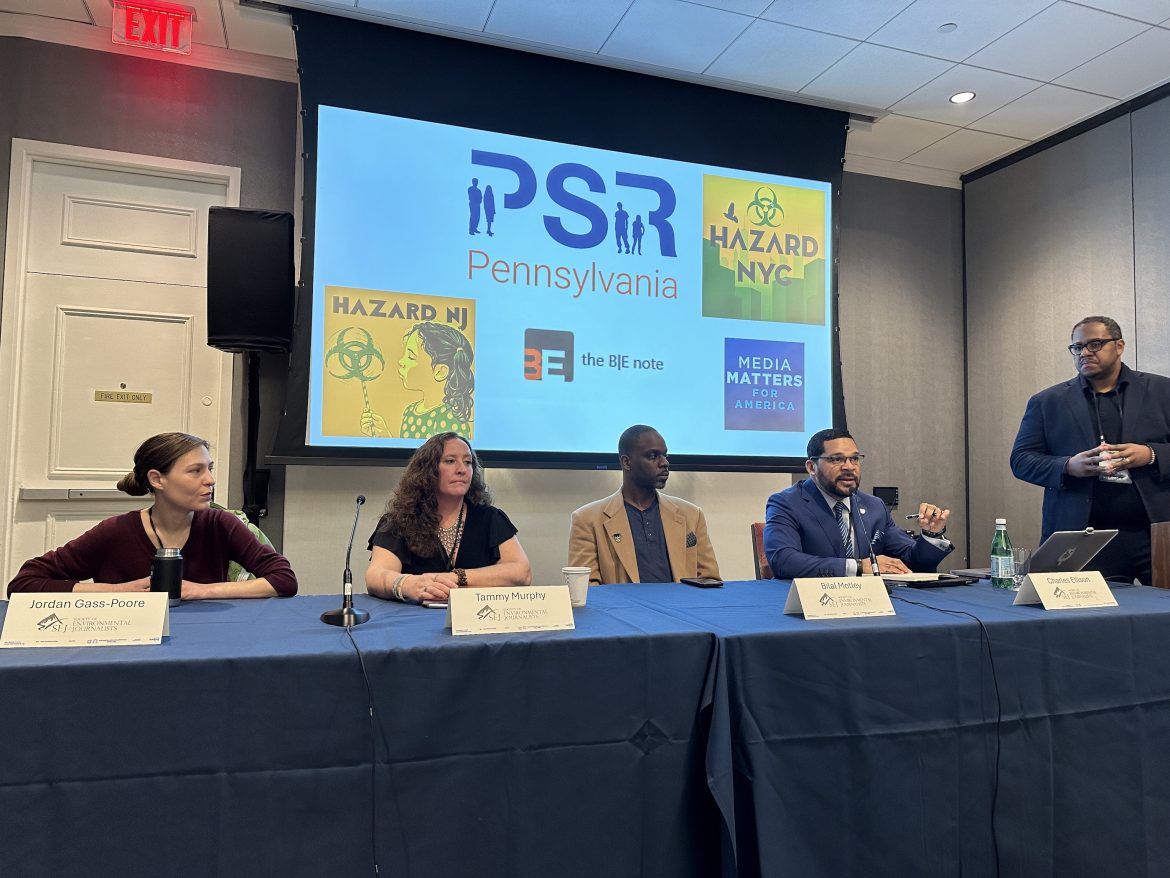
Moderator Evlondo Cooper and panelists Charles Ellison, Jordan Gass-Poorè, Bilal Motley and Tammy Murphy discuss reporting on environmental justice at a recent Society of Environmental Journalists conference
By Wajeeha Kamal
Editor’s note: This is one in a series of stories coming out of a recent meeting of the Society of Environmental Journalists in Philadelphia.
Communities are suffering in silence.
There’s no question that mainstream media doesn’t cover the systemic inequalities exposed and exacerbated by environmental habits, said Evlondo Cooper, senior writer for the Climate Energy Program at Media Matters for America.
Journalists, filmmakers and environmental advocacy groups examined the urgent need for the news media to evolve its approach to reporting environmental justice at a recent Society of Environmental Journalists conference in Philadelphia.
Panelists highlighted systemic reasons for the lack of mainstream media coverage of environmental problems that fall disproportionately on marginalized communities.
“While climate change rightfully commands increasing media attention, especially as we witness record-breaking climate impacts, journalists must not forget that the same industries and corporations driving global warming are poisoning the air, land and water of millions in communities across our country,” Cooper said.
The panelists agreed on the need to change newsrooms. They provided tips on how journalists must champion the role of nonwhite media outlets and integrate persons of color into mainstream reporting. They should include community voices disproportionately impacted by hazardous waste and pollution, the experts said .
Journalists are doing a good job covering Philadelphia, but that coverage doesn’t always show that parts of the city lack basic infrastructure like grocery stores and healthcare, said Bilal Motley, a filmmaker and actor.
According to the American Lung Association, pollution sources tend to be located near disadvantaged communities which makes Black people more susceptible to health threats. Lack of access to health care, grocery stores and good jobs, poorer job opportunities, dirtier workplaces and higher traffic exposure factors increase the risk of harm for these communities.
“You can’t even fight these things… the things that pollution is causing,” Motley said.
Charles Ellison, who directs the Council on Communities of Color at the Council of State Governments, advises mainstream journalists to understand the illiteracy crisis. Reporters need to figure out a way to navigate around the fact that more than half of American adults can’t read beyond the six to eighth-grade level, he said.
“It’s all about understanding that the environment, all things environment, all things climate crisis is every day,” Ellison said. “We have such rampant disinformation that also reflects low scientific literacy rates. That’s why there’s rampant disinformation and lack of awareness around major and critical science issues, like the climate crisis.”
Tammy Murphy, advocacy director for the Physicians for Social Responsibility Pennsylvania, said her organization also struggles with literacy.
“When you’re doing scientific and health-based research and presenting it, you have to make sure it is readable to everybody,” she said.
Murphy recommends the latest edition of the fracking “Compendium,” a collection of around 2,000 abstracts and links to medical, scientific and investigative reports about the consequences of oil and gas drilling, fracking, and infrastructure to journalists when breaking down complex scientific issues to their audiences.
The book covers everything that has been covered and publicized about fracking, she said.
“That’s something that our team is good at…. taking this knowledge and making it into stuff for people who struggle with reading or for children, making it into a more visually depicted story,” Murphy said.
Freelance investigative journalist Jordan Gass-Poorè said editors have told her they don’t trust community members who are anti-development advocates. She said the biggest resource for any of these stories is the community and that the community’s knowledge of place is essential to report.
“We’re a diverse society. So, let’s capture all the diversity of those perspectives in that reporting”, Ellison said.“Media outlets lament how they’re losing audience, well it’s not just social media that’s siphoning away your audience. It’s also the fact that you’re not allowing room for more perspectives.You’re not showing, capturing all this infinite array of diverse experiences…what Black people are dealing with in cities like Philadelphia.”
Collaboration is key. Mainstream media’s collaboration with disproportionately climate-impacted communities is empowering Ellison said The best way for mainstream media to better their relationship with communities is to partner with journalists from non-white outlets.
Ellison said that legacy media like CNN can pull and broadcast coverage from local outlets as broadcast segments.
Mainstream outlets need to tell their marginalized black and brown audiences that they are taking those steps, he said.
Resources for journalists covering environmental justice include The Solutions Project and The Uproot Project .